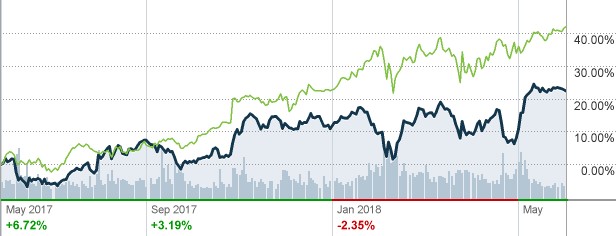About half a decade ago, the world's biggest enterprise software vendor, Microsoft, was a company whose very existence was threatened by the mobile and cloud revolution. The Redmond giant had little choice but to kick off a journey to transition from a company that sold on-premise Windows licenses to a company that derived its revenue from selling cloud subscriptions.
The process has been a drawn-out slog, but Microsoft has made impressive progress with more than $20 billion of its top line now coming from Azure, Dynamics 365 and Office 365 cloud subscriptions. MSFT stock has responded in kind, now growing at FANG-esque rates.
Apple's Booming Services Business
Enter Apple, another tech giant which a couple of years ago saw its iPhone gravy train nearly toppled by the likes of Samsung, Huawei, Xiaomi and a raft of Chinese copycats. Apple had come to rely so heavily on the iPhone that a good 86 percent of its top line growth over the past five years was directly tied to its iconic smartphones.
But after a decade of growing like a weed, Apple's growth eventually slowed before hitting reverse gear in 2016.
With iPhone clones popping up right left and center, Apple realized that the it could not depend on the iPhone to grow forever. With a huge installed base of more than a billion Apple hardware devices, why not focus on monetizing the cache of services that support them including App Store, iTunes, Apple Music, Apple Pay, iCloud, and AppleCar?
That worked like charm, and the Services Segment grew from being an auxiliary revenue category to Apple's new growth engine.
During the first quarter of 2018, Apple's Services business brought in $8.5 billion, good for a solid 18 percent year-over-year growth. The average Apple device now brings in a cool $30 in Services revenue from low-single-digits a couple of years ago. Meanwhile, Apple's revenue expanded 15.5 percent with 60 percent of that directly attributable to Services growth.

(Click to enlarge)
Source: MacRumors
Apple Can Borrow a Page From Microsoft
The fact that Services is now doing much of the heavy-lifting for Apple is great from an investment point of view because it offers better revenue visibility and longer growth runways.
Apple though could be leaving lots of money on the table--unlike Microsoft, Apple has failed to fully embrace subscription software. Apple is still stuck to the anachronistic desktop apps of the pre-cloud days. The company has a wide suite of Pro Apps that audio and visual professionals are supposed to download into their local hard drives. Mac users can purchase bundled Final Cut, Logic Pro , Mainstage 3 and Compressor for $630 or purchase each package separately for $300.
The company can conceivably host all these products in the cloud and charge monthly subscriptions through a Software-as-a-Service (SaaS) model. Related: Tech Icon Predicts A Big Future For Ethereum
Last year, Apple revealed that Final Cut Pro X had two million users. Microsoft Office 365 has more than 120 million business users alone--at $100/year a pop, that a lot of recurring revenue. Apple would likely see a huge influx of new users, and a nice recurring revenue stream, if it was to offer these services as a cloud subscriptions, which is the new norm.
APPL Stock Not Viewed Favorably
APPL stock has been able to avoid a roiling even through the thin years thanks to the company's copious dividends and share buybacks that encouraged investors to hang on. Still, it has not been able to return to its glory days and has even underperformed the broad technology sector:
AAPL vs. Technology Select Sector ETF(XLK) 12-Month Change

(Click to enlarge)
Source: Money CNN
But by going headlong into the cloud subscription business, AAPL stock, like MSFT, could manage to get its groove back again.
AAPL vs. MSFT 12-Month Change

(Click to enlarge)
Source: CNN Money
By Alex Kimani for Safehaven.com
More Top Reads From Safehaven.com

















